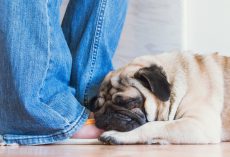This mistake is common amongst owners training their pets. Do you make this mistake?
Identifying the Problem Behavior and Its Triggers
The next step is to identify the problem behavior, how often it occurs, how severe it is, and what triggers it.The ultimate goal is to help your dog extinguish problem behaviors. But behavior modification training must be done when your pet is calm, because dogs don't learn well in a highly aroused state. Initial behavior modification efforts should take place outside the presence of the triggering event.
Identifying which situations seem to trigger your pet's aggressiveness is important. If your dog is aggressive at meal time, she should be fed in a quiet spot, and needless to say, she should not be disturbed while eating.
Trigger Avoidance with a Territorial Dog
If your dog snarls, growls or barks excessively looking out a window or door, or from behind your backyard fence, you'll need to block either his visual or physical access.Managing a Destructive Dog
First, remove all temptations (also known as avoiding triggers). If your dog gets into the garbage, place it behind a cabinet door with a lock or in another hard-to-reach spot.Provide your pet with plenty of exercise, attention, and toys that are mentally stimulating.
Managing Your Own Response to Problem Behaviors
When your dog is actively engaged in a problem behavior, your response must be calm and controlled.Try to remove your pet from the situation if it's safe to do so, or remove the trigger. Failing that, calmly try to redirect your dog's attention with a command he normally responds to, or attempt to distract him with a food treat, a favorite toy, a walk or a ride in the car.
Remember, you're only using these diversionary tactics to avert potential disaster. Doing so at every turn will only reinforce the behavior you ultimately hope to extinguish.
Punishment Creates More Problems and Solves Nothing
If you find the evidence of a problem behavior after the fact, for example, a puddle on the carpet or a shoe chewed beyond recognition, the only productive thing to do is clean up the mess and vow to avoid the trigger in the future. Ask yourself how your dog was left unsupervised long enough to relieve herself on the floor or destroy footwear, and decide what steps you'll take to avoid the problem next time.Being aggressive and punishing with a dog in a highly aroused, reactive state is a recipe for disaster. This type of response can cause the dog's behavior to escalate, resulting in injury to one or both of you.
The Goal of Trigger Avoidance and Control
The goal in managing your pet's problem behavior is to keep it from escalating while you work with your dog toward a more permanent solution.One of the main goals of positive reinforcement behavior therapy is to change the dog's underlying emotional state. Once your pet is no longer aggressively aroused and full of fear, she is open to learning different responses.
If you feel changing your dog's behavior is something you need help with, I recommend a consultation with a certified animal behavior specialist.
Setting Realistic Expectations
There are certain things your canine companion may never be able to do, and it's important for the bond you share and your pet's well being that you accept what you cannot change.Just as every human being is different — some people love crowds, for example, while others avoid them at all costs — your dog is an individual and can't be expected to adapt perfectly to every conceivable situation.
Prepare for some successes and some failures. Explore the limits of your dog's tolerance and when you reach them, you'll have a clear understanding of what you can and can't expect of her.
Now that you know the proper way of correcting any bad behavior in your pooch, you'll be able to see results! Understanding that every pooch has a different personality and learns differently is only the first step in being a better owner! Your pooch will thank you!
For more information on properly managing your dog's bad behavior, visit Healthy Pets.










